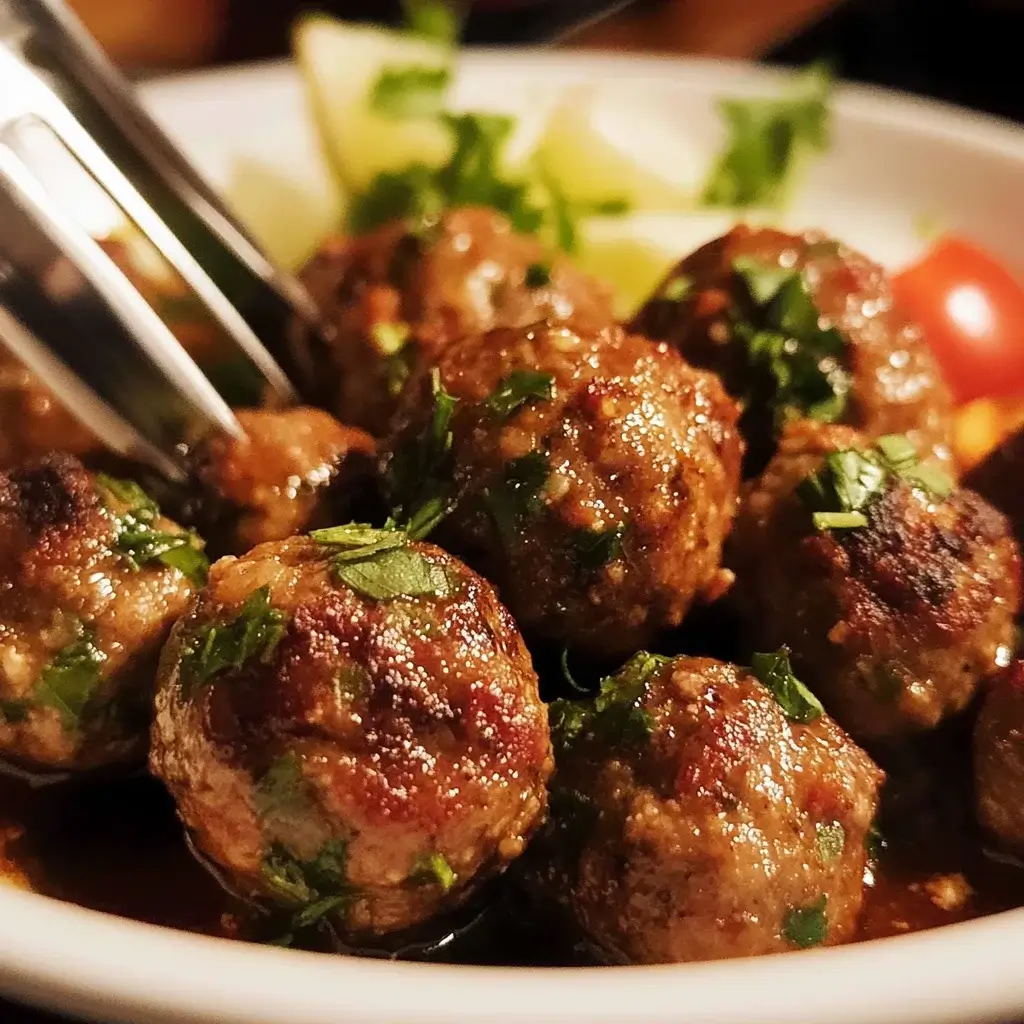It’s funny, but meatballs used to be something I associated with heavy, stodgy comfort food. Then I discovered Mediterranean cuisine, and my whole meatball world turned upside down! These Mediterranean Lamb Meatballs are a revelation. The first time I made them, my family devoured them in minutes. Even my picky eater, who usually shies away from anything remotely “herby,” was asking for seconds. What I love most is how light and vibrant they are, bursting with fresh flavors that transport you straight to a sunny taverna by the Aegean Sea. They’re incredibly easy to make, surprisingly healthy, and have become a regular weeknight staple in our home. Honestly, if you’re looking for a dish that’s both comforting and exciting, these meatballs are it – prepare to be amazed!
Ingredients: Your Mediterranean Pantry Essentials
- 1 lb (about 450g) Ground Lamb: The heart of our meatballs, providing rich, savory flavor. Opt for lamb with a decent fat content (around 15-20%) for juicier meatballs.
- 1 small Onion: Finely diced, it adds sweetness and depth, forming the aromatic base of the meatballs.
- 3 cloves Garlic: Minced garlic is crucial for that pungent, unmistakable Mediterranean zest. Fresh is always best for maximum flavor.
- 1/4 cup Fresh Parsley: Chopped parsley brings a bright, herbaceous freshness that cuts through the richness of the lamb.
- 2 tablespoons Fresh Mint: A signature Mediterranean herb, mint adds a cooling, slightly sweet, and incredibly aromatic dimension.
- 1 teaspoon Dried Oregano: Earthy and robust, oregano is a cornerstone of Mediterranean cooking, lending warmth and complexity.
- 1 teaspoon Ground Cumin: Warm and slightly smoky, cumin adds a touch of exotic spice, enhancing the overall flavor profile.
- 1/2 teaspoon Ground Coriander: Citrusy and slightly sweet, coriander complements cumin beautifully, adding another layer of aromatic spice.
- 1/4 teaspoon Red Pepper Flakes (Optional): For a gentle kick of heat, red pepper flakes add a subtle warmth without overpowering the other flavors.
- 1 large Egg: Acts as a binder, helping the meatballs hold their shape and adding moisture.
- 1/3 cup Breadcrumbs: Help to create a lighter, more tender meatball texture. Use panko for extra crispiness or regular breadcrumbs for a softer result.
- 2 tablespoons Olive Oil: The quintessential Mediterranean fat, used for cooking and adding richness and flavor. Extra virgin olive oil is recommended for its superior taste.
- 1 teaspoon Salt and 1/2 teaspoon Black Pepper (or to taste): Essential seasonings to enhance all the flavors. Use sea salt or kosher salt for the best taste.
Instructions: Crafting Your Perfect Mediterranean Lamb Meatballs
- Prepare the Aromatic Base: Start by finely dicing the onion and mincing the garlic. The smaller the pieces, the more evenly they will distribute throughout the meatball mixture and cook through.
- Sauté the Aromatics (Optional but Recommended): Heat about a tablespoon of olive oil in a skillet over medium heat. Add the diced onion and cook until softened and translucent, about 5-7 minutes. Then, add the minced garlic and cook for another minute until fragrant. Sautéing the onion and garlic mellows their raw bite and enhances their sweetness, contributing to a more nuanced flavor in the meatballs. Allow the sautéed mixture to cool slightly before proceeding.
- Combine the Meatball Ingredients: In a large mixing bowl, gently combine the ground lamb, sautéed onion and garlic (if using), fresh parsley, fresh mint, dried oregano, ground cumin, ground coriander, red pepper flakes (if using), egg, and breadcrumbs. Season generously with salt and freshly ground black pepper.
- Mix Gently, Don’t Overwork: Use your hands to gently mix all the ingredients together until just combined. The key here is not to overmix. Overmixing can lead to tough meatballs. Mix just until everything is evenly distributed.
- Test for Seasoning (Optional but Recommended): Before forming all the meatballs, you can test the seasoning. Take a small spoonful of the mixture and cook it in a skillet until cooked through. Taste it and adjust the seasoning in the main mixture as needed. This step allows you to perfect the flavor before committing to cooking all the meatballs.
- Form the Meatballs: Using your hands or a tablespoon or a small ice cream scoop for uniformity, form the meat mixture into meatballs. Aim for meatballs that are about 1.5 to 2 inches in diameter. Wet your hands lightly with water to prevent the meat mixture from sticking. You should get approximately 20-24 meatballs from this recipe, depending on the size you make.
- Choose Your Cooking Method: Baking or Pan-Frying:
- Baking (Healthier Option): Preheat your oven to 400°F (200°C). Place the meatballs on a baking sheet lined with parchment paper. Bake for 20-25 minutes, or until cooked through and lightly browned. Baking is a healthier method as it requires less added oil and allows the meatballs to cook evenly.
- Pan-Frying (Crispier Exterior): Heat about 2-3 tablespoons of olive oil in a large skillet over medium-high heat. Once the oil is hot, carefully add the meatballs to the skillet in batches, being careful not to overcrowd the pan. Cook for about 8-10 minutes, turning them occasionally, until they are browned on all sides and cooked through. Pan-frying creates a delicious crispy exterior while keeping the inside juicy.
- Ensure Meatballs are Cooked Through: Regardless of the cooking method, ensure the meatballs are cooked through. The internal temperature should reach 165°F (74°C). You can check this with a meat thermometer. The juices should run clear when pierced with a fork or knife.
- Serve and Enjoy: Once cooked, remove the meatballs from the oven or skillet. They are now ready to be served! They are fantastic on their own, with a dipping sauce, or as part of a larger Mediterranean meal. See the “How to Serve” section for delicious serving suggestions.
Nutrition Facts: A Wholesome Mediterranean Meal
(Per Serving, approximately 4 meatballs – Nutritional values are estimates and can vary based on ingredient brands and specific lamb fat content)
- Servings: Approximately 5-6 servings (4 meatballs per serving)
- Calories: Approximately 350-400 kcal
- Protein: 25-30g
(Note: These are estimated values. For precise nutritional information, use a nutrition calculator and input the specific brands and quantities of ingredients used.)
Preparation Time: Quick and Easy Mediterranean Flavor
- Prep Time: 20-25 minutes (includes chopping vegetables and mixing ingredients)
- Cook Time: 20-25 minutes (for baking) or 8-10 minutes per batch (for pan-frying)
- Total Time: Approximately 40-50 minutes
This Mediterranean Lamb Meatball recipe is perfect for a weeknight meal as it is relatively quick to prepare and cook. The majority of the time is spent in preparation, chopping the vegetables and mixing the ingredients, and then the cooking time is relatively short, especially if you choose to pan-fry the meatballs in batches. It’s a great option for a flavorful and satisfying meal without spending hours in the kitchen.
How to Serve: Versatile and Delicious Options
These Mediterranean Lamb Meatballs are incredibly versatile and can be served in countless delicious ways. Here are some ideas to get you started:
- With Creamy Tzatziki Sauce: A classic pairing! Serve the meatballs warm or at room temperature with a generous dollop of homemade tzatziki sauce for dipping. The cool, refreshing yogurt sauce perfectly complements the rich, savory meatballs.
- In Warm Pita Bread with Mediterranean Salad: Create flavorful and satisfying pita pockets. Stuff warm pita bread with the meatballs, a vibrant Mediterranean salad (tomatoes, cucumbers, red onion, olives, feta cheese, and a lemon-herb vinaigrette), and a drizzle of tzatziki or hummus.
- Over Lemon Herb Couscous or Rice: Serve the meatballs over a bed of fluffy couscous or rice that has been infused with lemon zest and fresh herbs like parsley and dill. This creates a hearty and complete meal.
- With Roasted Mediterranean Vegetables: Roast a medley of your favorite Mediterranean vegetables like bell peppers, zucchini, eggplant, red onion, and cherry tomatoes with olive oil, oregano, and garlic. Serve the meatballs alongside the roasted vegetables for a healthy and flavorful combination.
- As Part of a Mezze Platter: Include the meatballs as part of a larger Mediterranean mezze platter. Arrange them alongside hummus, baba ghanoush, olives, feta cheese, pita bread, stuffed grape leaves, and other Mediterranean dips and appetizers for a delightful sharing experience.
- In a Tomato-Based Sauce (Italian Inspired): While traditionally Mediterranean, these meatballs also work beautifully in a simple tomato sauce. Simmer the cooked meatballs in your favorite marinara sauce and serve them over pasta or polenta for a comforting, Italian-Mediterranean fusion dish.
- On Skewers as Appetizers: Thread the cooked meatballs onto skewers with cherry tomatoes, cucumber chunks, and olives for fun and flavorful appetizers at your next gathering. Serve with a dipping sauce like tzatziki or a lemon-herb vinaigrette.
Additional Tips: Elevating Your Mediterranean Meatballs
Here are 8 tips to help you make the best Mediterranean Lamb Meatballs:
- Don’t Overmix the Meat Mixture: Gentle mixing is key to tender meatballs. Overmixing develops the gluten in the breadcrumbs and toughens the meat. Mix just until all ingredients are combined.
- Use Fresh Herbs: Fresh parsley and mint are essential for the vibrant Mediterranean flavor. Dried herbs can be used in a pinch, but fresh herbs provide a much brighter and more aromatic result. If using dried herbs, generally use about one-third of the amount called for fresh.
- Sauté the Onions and Garlic: While optional, sautéing the onions and garlic before adding them to the meatball mixture mellows their flavor and adds a layer of sweetness. This step significantly enhances the overall taste of the meatballs.
- Add a Touch of Lemon Zest: For an extra burst of freshness and brightness, add the zest of half a lemon to the meatball mixture. Lemon zest complements the lamb and herbs beautifully, adding a zesty lift.
- Use Quality Olive Oil: Olive oil is a cornerstone of Mediterranean cuisine. Use good quality extra virgin olive oil for the best flavor, both in the meatballs and for cooking.
- Chill the Meatball Mixture (Optional): If you have time, chilling the meatball mixture in the refrigerator for about 30 minutes before forming the meatballs can help them hold their shape better during cooking and also allows the flavors to meld.
- Control the Size for Even Cooking: Aim for uniform meatball size so they cook evenly. Using a tablespoon or a small ice cream scoop can help achieve consistent size.
- Don’t Overcrowd the Pan (If Pan-Frying): When pan-frying, avoid overcrowding the skillet. Overcrowding lowers the temperature of the oil and can result in steamed rather than browned meatballs. Cook in batches to ensure proper browning and crisping.
FAQ: Your Mediterranean Meatball Questions Answered
Q1: Can I use ground beef instead of lamb?
A: Yes, you can substitute ground beef for lamb if you prefer. However, lamb has a distinct, slightly gamey flavor that is characteristic of Mediterranean cuisine. Ground beef will still be delicious, but the flavor profile will be slightly different. For a closer flavor profile to lamb, consider using a fattier cut of ground beef (like 80/20).
Q2: Can I make these meatballs gluten-free?
A: Absolutely! Simply substitute gluten-free breadcrumbs for regular breadcrumbs. Ensure all other ingredients are also gluten-free if you are strictly gluten-free. Almond flour or even finely ground oats can also work as gluten-free binders.
Q3: Can I freeze these meatballs?
A: Yes, these meatballs freeze beautifully. You can freeze them either cooked or uncooked.
* To freeze cooked meatballs: Allow them to cool completely, then place them in a single layer on a baking sheet and freeze until solid. Once frozen, transfer them to a freezer-safe bag or container. They can be reheated directly from frozen in the oven, skillet, or microwave.
* To freeze uncooked meatballs: Place the formed meatballs on a baking sheet lined with parchment paper and freeze until solid. Then, transfer them to a freezer-safe bag or container. When ready to cook, you can cook them directly from frozen, adding a few extra minutes to the cooking time.
Q4: Can I make these meatballs ahead of time?
A: Yes, you can prepare the meatball mixture ahead of time and store it in the refrigerator for up to 24 hours before cooking. You can also cook the meatballs ahead of time and reheat them when needed. They are great for meal prepping!
Q5: What is a good dipping sauce for these meatballs besides tzatziki?
A: Besides tzatziki, other delicious dipping sauces include:
* Hummus: Creamy and nutty, hummus is a classic Mediterranean dip that pairs wonderfully with lamb meatballs.
* Baba Ghanoush: Smoky eggplant dip adds another layer of Mediterranean flavor.
* Lemon-Herb Yogurt Sauce: A simpler version of tzatziki, made with plain yogurt, lemon juice, fresh herbs (like dill and parsley), and garlic.
* Spicy Harissa Yogurt: For a kick, mix harissa paste into plain yogurt for a spicy and flavorful dipping sauce.
* Tahini Sauce: A creamy sesame-based sauce that complements lamb beautifully.
Q6: Can I add cheese to these meatballs?
A: While not traditionally in this recipe, you can certainly add cheese! Feta cheese, crumbled into the meatball mixture, would add a salty, tangy flavor that complements the Mediterranean herbs. You could also add grated Parmesan or Pecorino Romano cheese for a more Italian-Mediterranean fusion.
Q7: How can I make these meatballs spicier?
A: To increase the spice level, you can:
* Increase the red pepper flakes: Add more red pepper flakes to the meatball mixture.
* Add a pinch of cayenne pepper: Cayenne pepper will add a more direct heat.
* Include finely chopped fresh chili: Finely diced fresh chili peppers like jalapeño or serrano can add both heat and fresh pepper flavor.
* Serve with a spicy dipping sauce: Offer a spicy dipping sauce like harissa yogurt or a chili garlic sauce on the side.
Q8: What are some good side dishes to serve with these meatballs?
A: Besides the serving suggestions mentioned earlier, other great side dishes include:
* Greek Salad (Horiatiki Salad): A classic and refreshing Mediterranean salad with tomatoes, cucumbers, onions, olives, feta, and a simple vinaigrette.
* Roasted Potatoes with Lemon and Herbs: Simple roasted potatoes tossed with olive oil, lemon juice, oregano, and rosemary.
* Green Beans with Garlic and Almonds: Sautéed or roasted green beans with garlic and toasted almonds.
* Quinoa Salad with Mediterranean Vegetables: A healthy and flavorful quinoa salad with chopped vegetables, herbs, and a lemon vinaigrette.
* Warm Pita Bread or Flatbread: Essential for scooping up meatballs and sauces.
Enjoy making and sharing these flavorful Mediterranean Lamb Meatballs! They are sure to become a new favorite in your kitchen.
Print
Mediterranean Lamb Meatballs
Ingredients
- Ground Lamb: The heart of our meatballs, providing rich, savory flavor. Opt for lamb with a decent fat content (around 15-20%) for juicier meatballs.
- Onion: Finely diced, it adds sweetness and depth, forming the aromatic base of the meatballs.
- Garlic: Minced garlic is crucial for that pungent, unmistakable Mediterranean zest. Fresh is always best for maximum flavor.
- Fresh Parsley: Chopped parsley brings a bright, herbaceous freshness that cuts through the richness of the lamb.
- Fresh Mint: A signature Mediterranean herb, mint adds a cooling, slightly sweet, and incredibly aromatic dimension.
- Dried Oregano: Earthy and robust, oregano is a cornerstone of Mediterranean cooking, lending warmth and complexity.
- Ground Cumin: Warm and slightly smoky, cumin adds a touch of exotic spice, enhancing the overall flavor profile.
- Ground Coriander: Citrusy and slightly sweet, coriander complements cumin beautifully, adding another layer of aromatic spice.
- Red Pepper Flakes (Optional): For a gentle kick of heat, red pepper flakes add a subtle warmth without overpowering the other flavors.
- Egg: Acts as a binder, helping the meatballs hold their shape and adding moisture.
- Breadcrumbs: Help to create a lighter, more tender meatball texture. Use panko for extra crispiness or regular breadcrumbs for a softer result.
- Olive Oil: The quintessential Mediterranean fat, used for cooking and adding richness and flavor. Extra virgin olive oil is recommended for its superior taste.
- Salt and Black Pepper: Essential seasonings to enhance all the flavors. Use sea salt or kosher salt for the best taste.
Instructions
- Prepare the Aromatic Base: Start by finely dicing the onion and mincing the garlic. The smaller the pieces, the more evenly they will distribute throughout the meatball mixture and cook through.
- Sauté the Aromatics (Optional but Recommended): Heat about a tablespoon of olive oil in a skillet over medium heat. Add the diced onion and cook until softened and translucent, about 5-7 minutes. Then, add the minced garlic and cook for another minute until fragrant. Sautéing the onion and garlic mellows their raw bite and enhances their sweetness, contributing to a more nuanced flavor in the meatballs. Allow the sautéed mixture to cool slightly before proceeding.
- Combine the Meatball Ingredients: In a large mixing bowl, gently combine the ground lamb, sautéed onion and garlic (if using), fresh parsley, fresh mint, dried oregano, ground cumin, ground coriander, red pepper flakes (if using), egg, and breadcrumbs. Season generously with salt and freshly ground black pepper.
- Mix Gently, Don’t Overwork: Use your hands to gently mix all the ingredients together until just combined. The key here is not to overmix. Overmixing can lead to tough meatballs. Mix just until everything is evenly distributed.
- Test for Seasoning (Optional but Recommended): Before forming all the meatballs, you can test the seasoning. Take a small spoonful of the mixture and cook it in a skillet until cooked through. Taste it and adjust the seasoning in the main mixture as needed. This step allows you to perfect the flavor before committing to cooking all the meatballs.
- Form the Meatballs: Using your hands or a tablespoon or a small ice cream scoop for uniformity, form the meat mixture into meatballs. Aim for meatballs that are about 1.5 to 2 inches in diameter. Wet your hands lightly with water to prevent the meat mixture from sticking. You should get approximately 20-24 meatballs from this recipe, depending on the size you make.
- Choose Your Cooking Method: Baking or Pan-Frying:
- Baking (Healthier Option): Preheat your oven to 400°F (200°C). Place the meatballs on a baking sheet lined with parchment paper. Bake for 20-25 minutes, or until cooked through and lightly browned. Baking is a healthier method as it requires less added oil and allows the meatballs to cook evenly.
- Pan-Frying (Crispier Exterior): Heat about 2-3 tablespoons of olive oil in a large skillet over medium-high heat. Once the oil is hot, carefully add the meatballs to the skillet in batches, being careful not to overcrowd the pan. Cook for about 8-10 minutes, turning them occasionally, until they are browned on all sides and cooked through. Pan-frying creates a delicious crispy exterior while keeping the inside juicy.
- Ensure Meatballs are Cooked Through: Regardless of the cooking method, ensure the meatballs are cooked through. The internal temperature should reach 165°F (74°C). You can check this with a meat thermometer. The juices should run clear when pierced with a fork or knife.
- Serve and Enjoy: Once cooked, remove the meatballs from the oven or skillet. They are now ready to be served! They are fantastic on their own, with a dipping sauce, or as part of a larger Mediterranean meal. See the “How to Serve” section for delicious serving suggestions.
Nutrition
- Serving Size: one normal portion
- Calories: 400
- Protein: 30g






